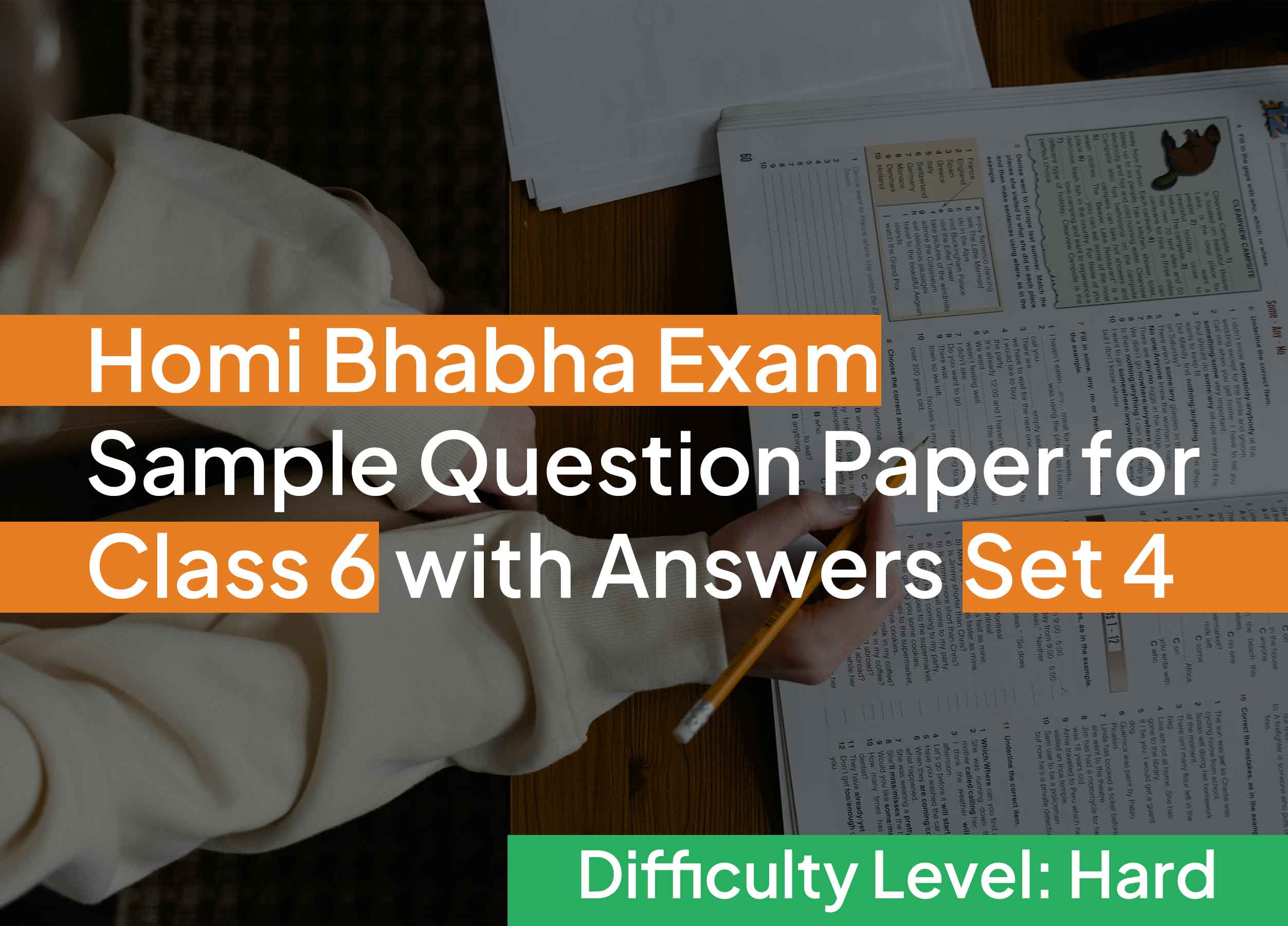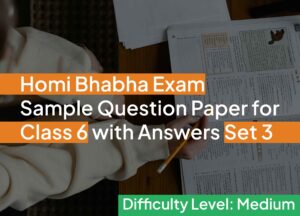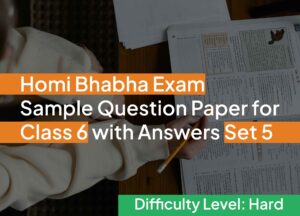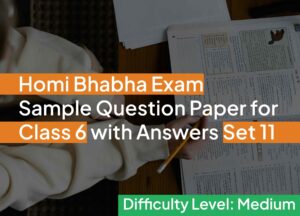Dr. Homi Bhabha Exam sample question paper for Class 6 with our comprehensive set 4 is designed specifically for students following the Maharashtra State Board curriculum, aligning perfectly with the textbooks for 4th, 5th, and 6th standards. This sample question paper is designed to challenge students with in-depth, analytical questions from Maharashtra State Board, CBSE, ICSE, and IB textbooks, covering fundamental science concepts at a high difficulty level.
With questions set at a hard difficulty level, students can effectively enhance their understanding and confidence. Each question aims to challenge students while reinforcing their knowledge, making this resource invaluable preparing for DHBBVS.
Which part of a plant helps in the process of reproduction?
a) Stem b) Root c) Flower d) Leaf
Answer: c) Flower
Explanation: The flower is the reproductive part of a plant, responsible for producing seeds.Which of these animals is considered cold-blooded?
a) Cat b) Dog c) Frog d) Monkey
Answer: c) Frog
Explanation: Frogs are ectothermic, meaning their body temperature depends on their environment.Which form of water can absorb more heat?
a) Ice b) Liquid water c) Steam d) All equally
Answer: c) Steam
Explanation: Steam can absorb more heat due to its high energy level compared to ice and liquid water.Which of the following is a type of root system found in grasses?
a) Taproot b) Fibrous root c) Aerial root d) Adventitious root
Answer: b) Fibrous root
Explanation: Grasses have fibrous roots, which spread out in the soil, providing strong anchorage.
The process of a solid changing directly into a gas without passing through a liquid state is called:
a) Condensation b) Evaporation c) Sublimation d) Deposition
Answer: c) Sublimation
Explanation: Sublimation is the process where a solid turns directly into a gas, like dry ice.What is the primary function of red blood cells in the human body?
a) Fighting infections b) Transporting oxygen c) Digesting food d) Removing waste
Answer: b) Transporting oxygen
Explanation: Red blood cells carry oxygen from the lungs to all body tissues.Which part of the plant cell contains chlorophyll?
a) Nucleus b) Cell wall c) Cytoplasm d) Chloroplast
Answer: d) Chloroplast
Explanation: Chloroplasts contain chlorophyll, essential for photosynthesis.In the process of photosynthesis, plants absorb sunlight through which part?
a) Stem b) Roots c) Leaves d) Flower
Answer: c) Leaves
Explanation: Leaves have chlorophyll, which captures sunlight to produce food for the plant.Which of the following correctly describes the energy transformation in an electric bulb?
a) Chemical to light b) Light to heat c) Electrical to light and heat d) Kinetic to electrical
Answer: c) Electrical to light and heat
Explanation: In a bulb, electrical energy converts to both light and heat energy.Which vitamin is crucial for blood clotting in the human body?
a) Vitamin A b) Vitamin B c) Vitamin K d) Vitamin D
Answer: c) Vitamin K
Explanation: Vitamin K plays a vital role in the clotting process to prevent excessive bleeding.
In the solar system, which planet has the longest day?
a) Mercury b) Venus c) Earth d) Jupiter
Answer: b) Venus
Explanation: Venus has the longest rotation period, taking about 243 Earth days to complete one rotation.What type of motion does the Earth exhibit as it travels around the Sun?
a) Oscillatory motion b) Rectilinear motion c) Circular motion d) Rotational motion
Answer: c) Circular motion
Explanation: Earth’s orbit around the Sun is nearly circular, exhibiting circular motion.The powerhouse of the cell, which generates energy, is known as the:
a) Nucleus b) Chloroplast c) Mitochondria d) Golgi body
Answer: c) Mitochondria
Explanation: Mitochondria produce energy (ATP) and are thus known as the powerhouse of the cell.Which is the most reactive element among the following?
a) Sodium b) Potassium c) Calcium d) Magnesium
Answer: b) Potassium
Explanation: Potassium is highly reactive, especially in contact with water.In which layer of the atmosphere do most weather phenomena occur?
a) Troposphere b) Stratosphere c) Mesosphere d) Thermosphere
Answer: a) Troposphere
Explanation: Most weather phenomena, including rain and storms, occur in the troposphere.What is the pH of pure water?
a) 0 b) 7 c) 10 d) 14
Answer: b) 7
Explanation: Pure water has a neutral pH of 7.The tilt of the Earth’s axis causes:
a) Day and Night b) The seasons c) Lunar phases d) Ocean currents
Answer: b) The seasons
Explanation: The Earth’s tilted axis causes seasonal changes as different parts of the Earth receive varying sunlight.Which cell structure is responsible for controlling cell activities?
a) Mitochondria b) Ribosome c) Nucleus d) Endoplasmic Reticulum
Answer: c) Nucleus
Explanation: The nucleus contains genetic material and controls cellular activities.Which mineral is required for the formation of hemoglobin in the blood?
a) Calcium b) Iron c) Sodium d) Potassium
Answer: b) Iron
Explanation: Iron is essential for hemoglobin formation, which carries oxygen in the blood.Which of these processes involves liquid changing to solid?
a) Evaporation b) Melting c) Freezing d) Sublimation
Answer: c) Freezing
Explanation: Freezing is the process where a liquid turns into a solid when cooled.What is the name of the process by which plants release oxygen into the atmosphere?
a) Respiration b) Digestion c) Photosynthesis d) Transpiration
Answer: c) Photosynthesis
Explanation: During photosynthesis, plants convert sunlight into energy and release oxygen as a byproduct.Which component of blood helps in clotting?
a) Red blood cells b) White blood cells c) Platelets d) Plasma
Answer: c) Platelets
Explanation: Platelets are the blood cells responsible for clotting, helping to prevent excessive bleeding.What causes the phases of the moon?
a) Earth’s rotation b) Earth’s tilt c) Moon’s rotation d) Moon’s orbit around Earth
Answer: d) Moon’s orbit around Earth
Explanation: The phases of the moon occur due to the changing positions of the moon, Earth, and the sun.Which of the following is not a renewable source of energy?
a) Solar energy b) Wind energy c) Natural gas d) Hydroelectric power
Answer: c) Natural gas
Explanation: Natural gas is a non-renewable fossil fuel, while the others are renewable sources.What is the main reason we experience seasons?
a) Earth’s rotation b) Earth’s revolution c) Earth’s tilt on its axis d) Distance from the sun
Answer: c) Earth’s tilt on its axis
Explanation: The tilt of Earth’s axis as it orbits the sun causes seasonal changes.Which element is necessary for the formation of bones and teeth?
a) Iron b) Calcium c) Potassium d) Sodium
Answer: b) Calcium
Explanation: Calcium is essential for the development and maintenance of bones and teeth.Which process involves plants losing water through tiny openings in leaves?
a) Photosynthesis b) Respiration c) Transpiration d) Absorption
Answer: c) Transpiration
Explanation: Transpiration is the process of water movement through plants and evaporation from leaves.The primary purpose of the human nervous system is to:
a) Produce hormones b) Support the skeletal system c) Transmit signals throughout the body d) Transport oxygen
Answer: c) Transmit signals throughout the body
Explanation: The nervous system transmits electrical signals to coordinate bodily functions.
Who is known as the father of genetics?
a) Charles Darwin b) Gregor Mendel c) James Watson d) Alexander Fleming
Answer: b) Gregor Mendel
Explanation: Gregor Mendel is known as the father of genetics for his work on pea plants and heredity.Which of these is an example of a noble gas?
a) Nitrogen b) Oxygen c) Helium d) Chlorine
Answer: c) Helium
Explanation: Helium is a noble gas, known for its stability and low reactivity.What is the approximate boiling point of water at sea level in Fahrenheit?
a) 100°F b) 150°F c) 180°F d) 212°F
Answer: d) 212°F
Explanation: At sea level, water boils at 212°F or 100°C.Which vitamin is synthesized in the skin when exposed to sunlight?
a) Vitamin A b) Vitamin C c) Vitamin D d) Vitamin K
Answer: c) Vitamin D
Explanation: The body synthesizes Vitamin D when exposed to sunlight.What is the atomic number of Carbon?
a) 4 b) 6 c) 8 d) 12
Answer: b) 6
Explanation: Carbon has an atomic number of 6, indicating it has six protons.What instrument is used to measure atmospheric pressure?
a) Thermometer b) Barometer c) Anemometer d) Hygrometer
Answer: b) Barometer
Explanation: A barometer measures atmospheric pressure, often used in weather forecasting.Which planet is known as the Red Planet?
a) Jupiter b) Saturn c) Mars d) Neptune
Answer: c) Mars
Explanation: Mars is called the Red Planet due to its reddish appearance, caused by iron oxide.Who formulated the laws of motion?
a) Albert Einstein b) Isaac Newton c) Galileo Galilei d) James Maxwell
Answer: b) Isaac Newton
Explanation: Isaac Newton formulated the three laws of motion, which describe the relationship between motion and forces.Which gas do plants primarily take in for photosynthesis?
a) Oxygen b) Nitrogen c) Carbon Dioxide d) Hydrogen
Answer: c) Carbon Dioxide
Explanation: Plants absorb carbon dioxide from the air for photosynthesis, producing oxygen as a byproduct.What element is common in all organic compounds?
a) Nitrogen b) Hydrogen c) Carbon d) Oxygen
Answer: c) Carbon
Explanation: Carbon is the essential element in all organic compounds due to its ability to form stable bonds with many elements.Who is known for the theory of relativity?
a) Isaac Newton b) Albert Einstein c) Marie Curie d) Michael Faraday
Answer: b) Albert Einstein
Explanation: Albert Einstein developed the theory of relativity, revolutionizing modern physics.What is the main component of natural gas?
a) Methane b) Carbon dioxide c) Propane d) Ethane
Answer: a) Methane
Explanation: Methane is the primary component of natural gas, making it highly combustible and efficient for energy.
If you find this useful, share it with your friends… so they can join you in preparing for Dr. Homi Bhabha Balvaidnyanik Competition or DHBBVS. Together, you can tackle these questions, discuss the answers, and strengthen your knowledge base.
Start reading, keep preparing and stay focused! Let’s achieve greatness together!




